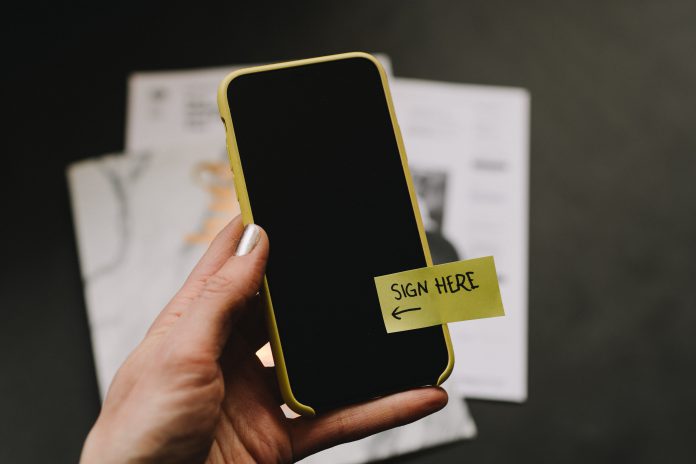As more people move towards online interactions with financial services organisations, firms are prioritising ways to improve the quality of these customers’ and employees’ interactions. Digital signatures could be the core feature to make a firm stand out from the crowd.
OneSpan has released a new webinar, ‘The Urgent Need for Trusted Digital Signatures in Europe’. The hour-long video explores how the pandemic has transformed digital engagement and customer expectations, how digital signatures are accelerating digital transformation in an array of business processes and explores a selection of use cases.
The presentation kicked off with a stat from Enza Iannopollo, Principal analyst at Forrester, that showed how the pandemic has changed the way consumers are making their buying decisions and engaging with companies. Forrester’s research found that 49% of French consumers have changed the way they shop because of the pandemic. Furthermore, 63% of UK consumers use technology more than they did last year when engaging with a company and 54% of UK consumers said the pandemic changed their purchase priorities.
Iannopollo explained that the pandemic has encouraged more people to turn to digital operations. This does not mean they will exclusively engage with a company through online means, but there will be a hybrid engagement that uses face-to-face interactions and online engagements.
Evidence of this was highlighted further with the fact that according to Iannopollo’s presentation, Forrester’s research found a quarter of consumers in Spain and the UK believe they will visit their branch less in the future. Similar trends are present in Italy and France as well, with 19% and 13%, respectively, of consumers stating the same opinion.
Iannopollo explored the evolving relationship between consumers and their bank. She provided several more stats, all which hinted that consumers, at least in the UK, Spain, France and Italy, are becoming more dependent on digital interactions when engaging with their banks.
With such an importance being placed on the digital world, firms across Europe are looking at where they focus their digitalisation efforts. One of the key areas of focus for companies is improving the customer and employee experiences. But another related priority companies have is using digitalisation to further their differentiation within the market.
In the webinar, Iannopollo said, “For me, this is what digital transformation is all for. Shifting our business to digital means building a competitive edge. The aim of digital transformation is making sure you stand out as a business. It is a mean to ensure that your customers, employees and partners recognise your brand in the marketplace and that your capabilities can deliver faster to market, and serve customers where they need it and when they need it. To me the idea of creating differentiation in the marketplace through digital transformation is one big priority.”
Using digital signatures to boost engagements
One effective way to transform experiences is by moving to digital signatures, Iannopollo said in the webinar.
These types of services support the ability to sign a document online and create a legally binding agreement. When looking to implement a digital signature solution, the company needs to assess the level of risk involved in the engagement. The higher the risk, the more likely a company will need to rely on more accurate mechanisms to verify identities of signees.
When looking to work with a vendor, the firm also needs to be aware there are various types of solutions. One of these is digital trust platforms. These are solutions that have strong identity verification processes and are designed to build deep trust. This can include qualified certificates, time stamps, archiving and more.
Other digital signature providers are the digital transformation platforms, which offer an array of tools but are not as focused on deep-level trust, eSignature specialist tools that provide simple identity verification, and finally, PKI specialist solutions that have native cryptographic capabilities.
With a lot of options available, it comes down to the firm to build a risk-based approach to understand what the right process and technology for them is. Not all companies will have high-risk transactions and will be suited to simple tools, while others will be the opposite.
But whatever vendor a company picks, Iannopollo is confident they can improve the customer and employee experience with smoother and more effective engagements. This will also ensure staff can boost their efficiency by focusing more time on more important tasks.
Importantly, Iannopollo also sees digital signatures as a way to foster innovation within a business. Incorporating this type of technology into a process also increases organizational education and comfort with leveraging these tools to digitise and simplify cumbersome processes. Thiscan help organizations uncover new opportunities where they can deploy the technology for better customers’ and employees’ outcomes.
How to get electronic signatures right
The webinar also features OneSpan vice president of product marketing Rahim Kaba. Kaba stated that trust is a key component in the digital world. It is crucial for firms to build and maintain trust in digital environments with customers and partners, as well as employees. However, building trust can be tricky as it involves storing sensitive information that can flow across the whole of the business.
If a firm is unable to maintain that trust it could lead to a high rate of customer churn, low adoption, brand erosion and other negative problems for a company. Kaba added, “When implementing technologies like electronic signatures, it is important to keep this in mind – are you able to achieve a high level of trust when interacting with your signers, especially when in remote and digital channels?”
OneSpan, which has designed its own electronic signature tool capable of automating workflows and boosting customer experiences, has noticed two common use cases for its technology. The first is around B2C processes and engaging with people outside the organisation. But OneSpan has also noted a rise in the use of it in internal environments. Kaba stated that both use cases are going to have their own requirements and needs, but the B2C side is going to need more identity considerations.
Just because a signature is electronic, it doesn’t mean the involved parties need to be in separate locations. In-person digital signatures are a common sight and often involve a shared device the signee can use to sign. These interactions would typically have some level of identity verification, such as showing a driver license.
However, remote signing is where digital signatures can be harder. This will mean the signee will not simply be able to show their passport to the person, so the signature device will typically need to have some added level of user authentication. Kaba stated that the pandemic has increased the weariness of fraud and encouraged more people to bolster their verification capabilities.
So, when should a signee provide proof of identity? Kaba explained there are multiple times in the process when this could be completed. The most common stage is before accessing the document. This could be achieved through ID verification checks, biometric verification, such as taking a selfie, clicking a link in an email, entering a code from a text or something else.
The second time where identity might be required is when signing the document. This can be completed through personal digital identity certificates, which can be stored locally through a smart card or government ID. Alternatively, some of these certificates are held by trusted service providers.
If a firm decides they need to implement a digital identity solution, Kaba believes it is best to use an enhanced authentication certificate.
An example of this would be OneSpan’s solution, which ensures the highest-level of identity assurance. It achieves this through several stages. The first is by taking a picture of a government-issued identification document and analysing the image to ensure it is a legitimate document and has not been spoofed. Following this, Kaba explained a need for a second level of authentication in the form of taking a selfie. OneSpan’s solution asks the user to take a selfie to verify this is the same person as that on the document. An important part of this is being able to use liveness detection, which asks the user to turn their head and blink to ensure it is really them and not a spoof. Once both stages are complete, a company can be certain the person is who they claim to be and then register their signature to the account.
To find out more about digital transformation and what role electronic signatures plays, watch the full webinar here.
Copyright © 2021 FinTech Global











